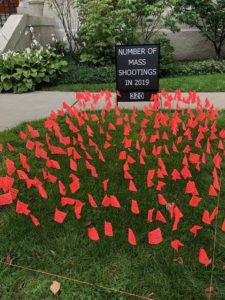 Every once in awhile I will open my email and see a familiar phrase. Usually it starts with some form of praise for my preaching or heart for an issue, but then it ends with that characteristic refrain: “You’ve got to learn to stay in your lane.” The phrase always gives me pause since it is an inherently theological claim about what the church ought to be up to in the world, and it prompts the question, “What is the church’s lane?”
Every once in awhile I will open my email and see a familiar phrase. Usually it starts with some form of praise for my preaching or heart for an issue, but then it ends with that characteristic refrain: “You’ve got to learn to stay in your lane.” The phrase always gives me pause since it is an inherently theological claim about what the church ought to be up to in the world, and it prompts the question, “What is the church’s lane?”
“What other institutions are ready to say that moral leadership means making tough choices and that those choices must be oriented to the flourishing of society’s most vulnerable?”
Some will say the church ought to focus on proclaiming the good news, or calling Christians to works of mercy or giving comfort to those experiencing grief. All these things are true, but I have come to realize that one of the key marks of a spirit-filled, 21st-century church is the teaching and modeling of moral leadership. How curious that the institution that has failed in leadership so spectacularly and publicly over the past several decades would be one of the institutions in American life that is poised to make an impact on this front by calling leaders to account and providing a space for congregants to discern what moral leadership looks like in their contexts.
And yet, what other institutions have a robust set of principles that should guide leadership? What other institutions are ready to say that moral leadership means making tough choices and that those choices must be oriented to the flourishing of society’s most vulnerable? What other institutions get to speak to their constituents once a week on topics of import, ideally helping them become moral leaders themselves in their communities?
Not only is there potential for the church to have a major impact on national and local discussions and public policy, but the church also has certain skills that it would be foolish to ignore. One that readily comes to mind is ritual. Churches have a lot of practice at creative storytelling using symbols, since that’s pretty much what liturgy amounts to. We gather together every week, reading and applying ancient biblical texts in new, hopefully exciting ways.
 The congregation I serve as senior minister recently put this skill to good use to address the critical issue of gun violence. We created a display on our front lawn that noted the number of mass shootings nationwide so far this year. We then took orange flags, a description of each and every mass-shooting incident, and wrote a prayer, drew an image or wrote a description of the event on each flag before planting them in front of the sign that noted the number of mass shootings in 2019.
The congregation I serve as senior minister recently put this skill to good use to address the critical issue of gun violence. We created a display on our front lawn that noted the number of mass shootings nationwide so far this year. We then took orange flags, a description of each and every mass-shooting incident, and wrote a prayer, drew an image or wrote a description of the event on each flag before planting them in front of the sign that noted the number of mass shootings in 2019.
The result was a poignant scene of 320 flags with prayers, descriptions, hopes and images written on them, solemnly depicting the depth of grief that our nation bears.
Each week for a month we will update the total as these tragic events recur. We will plant new flags, make new art and gather to hear from local organizers who are fighting to solve our gun violence epidemic in America. At the end of our month-long ritual, we will mail these flags to members of Congress, urging them not just to take action on gun violence, but to embrace a broader ethic of moral leadership – one that takes risks for the sake of our community’s most vulnerable.
Our ritual action told a story. There have been more mass shootings so far in 2019 than days in the year, and we are a community that is dedicated to doing church in the shadow of that reality. While we don’t have all the answers, we have determined to address this issue from the pulpit and to host community conversations about how we can take meaningful action. In short, we are daring to proclaim loudly that “this is our lane.”
“We will mail these flags to members of Congress, urging them not just to take action on gun violence, but to embrace a broader ethic of moral leadership.”
The Church cannot afford to be silent about gun violence in America, not only because of the lives it claims, but also because it is connected to issues such as homophobia, misogyny and racism. We ought to have something to say to our culture. Many of us have had the experience of expecting other institutions to step up to the plate and to help lead on this issue. These institutions’ failure to lead puts pressure on the church to step into its ancient role of social witness, one that has been all too easily cast aside. The Church must step forward and claim its lane.
Church leaders must also claim their lane of moral leadership on this issue (and others). As an American Baptist pastor, leading my congregation in the ritual action described above was the result of moral clarity about what the goals of my leadership ought to be in a time of gun violence. It was spurred by the recent array of mass shootings that dominated our news cycle in the summer of 2019 and my deep sadness about the state of our country.
Clergy must get clear about what they want to accomplish and why they want to accomplish it. They also need to be clear and transparent with congregants about those priorities; that too is a mark of strong moral leadership in congregational settings. Preaching about controversial issues like gun violence is not easy. Most of us have had a teacher or mentor share a list of topics that could get you fired if you preach about them. More than likely, “guns” was on that list. Such obstacles to clergy leadership are only overcome by a clear sense of God’s calling and direction in one’s ministry. Anything else will lead to an easy way out.
As our congregation’s ritual action on gun violence enters its third week, no one from my congregation or our city has sent me the “stay in your lane” refrain, but I know how I would respond if I got that message today. This is our lane. I may not be an elected politician, a sociologist, a public health professional or a doctor, but I am a minister, and I am compelled to speak out about gun violence.
